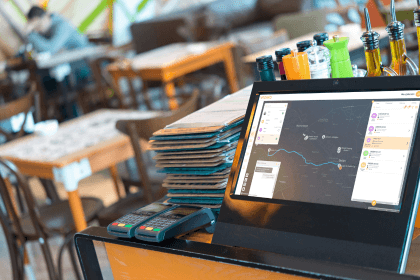
Why employing delivery drivers can help to solve gig economy pitfalls
March 30, 2023
Restaurant delivery is on the rise and having a scalable strategy is vital. Learn how to build a solid food business delivery strategy today!

Have you ever sat down to develop your food business’ food delivery strategy and thought – where to begin?
Don’t worry. You’re not the first, and you won’t be the last.
With the restaurant and takeaway industry continuing to evolve, more customers than ever are turning to food delivery services for convenience.
With this increasing demand, however, comes a lot of pressure to accept and fulfil more orders, improve customer satisfaction AND generate high levels of revenue, all at the same time.
Creating a comprehensive restaurant or food business delivery strategy requires attention to detail.
This includes navigating the current climate, recognizing trends, analyzing data, researching the competition, and of course, adapting quickly.
Even though many restaurant owners are familiar with handling take-out orders, creating a strategy specifically focused on optimizing delivery efficiency can be overwhelming.
This article will explore how you can create a foolproof restaurant delivery business plan that will help you to improve the customer experience and capture market share, all whilst staying within your budget!

The last few years have been challenging for the food & hospitality industry.
Many restaurants have had to adapt to a delivery-only model without any previous experience on how to handle delivery orders.
At the time, it looked like a net positive for both restaurants and customers. We could finally order takeaway from our favorite restaurant brand – life was sweet!
Very quickly, however, the industry experienced delivery fee hikes and an unhappy customer base due to long delivery times and higher delivery fees.
When restaurants finally got the green light and were told things were going back to ‘normal’, they were quickly acquainted with a new warning sign – an incoming recession.
With the cost of living on the rise, it’s no surprise that people are backtracking and trying to cut costs where they can.
And yes, this does include switching from the dine-in model to takeaway for many.
As a result, right now is the best time to leverage this unprecedented demand for food delivery.
To get started on your strategy building (or before you even consider implementing a tech solution) it’s important to get your foundations right by conducting competitor analysis, reading up on trends/news, and collecting customer feedback.
Here’s how to do it:
1. Take part in the ultimate crime.
Order from your competitors to research how they’re making the delivery experience better for their customers and business.
Try to identify if they deliver to customers on time, check what marketplace or food delivery apps they list on, or if they have switched to a dark kitchen model. Additionally, take a look at their google reviews. The customer is always right after all.
2. Ask customers and team members for feedback on ways your restaurant can improve the delivery experience.
It’s hard to fix something if you’re unaware that it is broken. Reach out to your customers and team members to make sure that things are running smoothly and that they are happy with the delivery experience.
3. Read the news – this may seem like a simple task but the industry changes on an hourly basis.
If you’re not up-to-date on what’s happening in the industry, you’re missing out on opportunities such as new social media food trends that could help your brand to go viral.
If you are too busy, make sure to sign up for relevant news outlets or newsletters to keep up-to-date.
The ability to adapt and be flexible in your approach has become a necessary skill to have in every industry. Restaurant brands are no exception.
The most important advice we can give is to stay informed and do your research.

With any new strategy, certain aspects of your business need to change and evolve. A restaurant food delivery strategy is no different.
Small, incremental changes can be the difference between success and failure for your food business. Most importantly, don’t be afraid to try something new and experiment.
Your pivot to a new business model could include the following:
Leveraging social media to alert existing and potential customers about your new delivery capabilities.
This includes any existing promotional offers or business updates such as what third-party delivery service providers your business is using. There are DoorDash loyalists out there y’know?
Consider a multi-channel approach that includes sending push notifications, marketing emails, and SMS to your customers. This way, your customers won’t (and truly can’t) miss out on any offers or updates.
Bonus tip: Don’t go overboard here. Constant notifications, emails, and social media posts can be extremely irritating for customers.
Adapt your menu to suit the food delivery business model.
Some foods don’t travel as well as others. This often results in toppled-over tacos or sideways subs.
Remember, you want your customers to have the best experience possible. To ensure this, you need to make sure your menu items are suitable for food delivery.
Take a look at your existing delivery model to see if there are any noticeable red flags to signal you need help.
With this, consider the distance your team covers and any obstacles that could stand in the way of the last-mile delivery process such as traffic build-up or construction.
With this, however, make sure you’re not selling yourself short.
Delivery drivers are heroes, don’t undervalue their delivery capabilities & speed!

Implementing a delivery service is not an easy feat. As a matter of fact, it can be extremely costly.
Most of these costs are associated with;
Paying your drivers adequately and fairly. If you don’t do this, you may have to deal with a team of delivery drivers that simply do not want to work for your restaurant.
Integrating a new technology such as food delivery software. There are many different providers in the market right now. Consider using one that is restaurant focused.
Increasing your marketing efforts. This often requires additional resources, such as hiring an external agency, copywriters, or running costly promotions.
Last-mile delivery charges. We all know by now that third-party apps can charge up to 30% in delivery fees.
Try to reduce these delivery rates by integrating with a delivery management system that has an extensive list of integrations or strategic partnerships to help provide restaurants with low-cost delivery fees.
Have clear expectations from your delivery management provider.
They should not only offer you access to lower delivery fees, but also a set of features that are uniquely designed for restaurants to make their delivery channel more profitable.
Such features should include order overflow or order stacking.
These features will help you to capture 100% of your order volume by being able to send excess orders to third-party fleets as well as drive down costs by paying one delivery fee for multiple orders located in a similar location.
With a solution like this not only will you drive down delivery costs, you will generate even more revenue with the ability to maximize fulfillment levels and reduce delivery times.
Feeling a little overwhelmed? Or are you worried about staying within budget?
Understandable.
Below you can find a number of ways you can ensure you are keeping costs low and staying within budget all while keeping quality and consistency high.
Consider simplifying your food delivery menu.
This will ensure inventory costs are better controlled. The fewer supplies needed, the less space required. After all, renting a restaurant space is not cheap!
Choose a food delivery vendor that incorporates branding solutions within its offerings.
That way, your marketing costs for any delivery campaigns will be bundled along with the software you’re using keeping your expenses cheap as chips!

Even though it sounds like a scary word, data is a powerful tool for any business, particularly when it comes to optimizing delivery service.
Analyzing the right delivery data can aid future decision-making as well as help you to understand your customers’ behavioral patterns.
By using the right food delivery software you can utilize reporting tools to dive a little deeper into the metrics that matter.
For example, delivery times or the reasons behind canceled food orders. This will help you to spot (and repair!) the gaps in your delivery service.
Consider analyzing metrics such as…
Distribution of jobs based on days and times – This will help you to capture your busy vs non-busy delivery times. Metrics like this will aid efficiency by helping you to appropriately staff your restaurant during peak and off-peak hours!
Canceled deliveries – Analyzing when or how deliveries were canceled will help you to identify why they were canceled. This will help you to get to the root of the problem and prevent future cancellations.
Driver reporting – Analyzing your drivers’ performance can help you to identify any unusual or suspicious activity. For example, if a driver has taken unauthorized breaks, wrong delivery routes, or had other issues during their shift.
Gathering and analyzing metrics such as these will be game-changing for your restaurant’s delivery service.
Not only will they increase predictability when it comes to delivery, but they will also help to measure delivery efficiency.
All you have to do is take one look at Papa Gino’s case study to see how easily it can be done.
In summary, creating a foolproof delivery strategy for a restaurant business requires careful consideration, time, and of course, money.
There are many factors you need to take into consideration before you jumpstart the process such as the type of food you serve, the target audience you’re trying to reach, the costs involved with delivery, and the best way to promote your restaurant.
By implementing an effective framework that combines your marketing strategy with operational considerations, restaurant brands, like yours, can benefit from an efficient delivery system that meets the needs of their customers while ensuring they’re seeing ROI.
If others can do it, you can too.
Rethinking and investing in your delivery channel will be the best business decision you make. But, only if you do it right.
If you’re looking to take the next step, book a call with our team of delivery experts who can walk you through the benefits of implementing a new delivery strategy for your restaurant.
Read more about the restaurant delivery industry below!

March 30, 2023

September 4, 2022

February 24, 2023